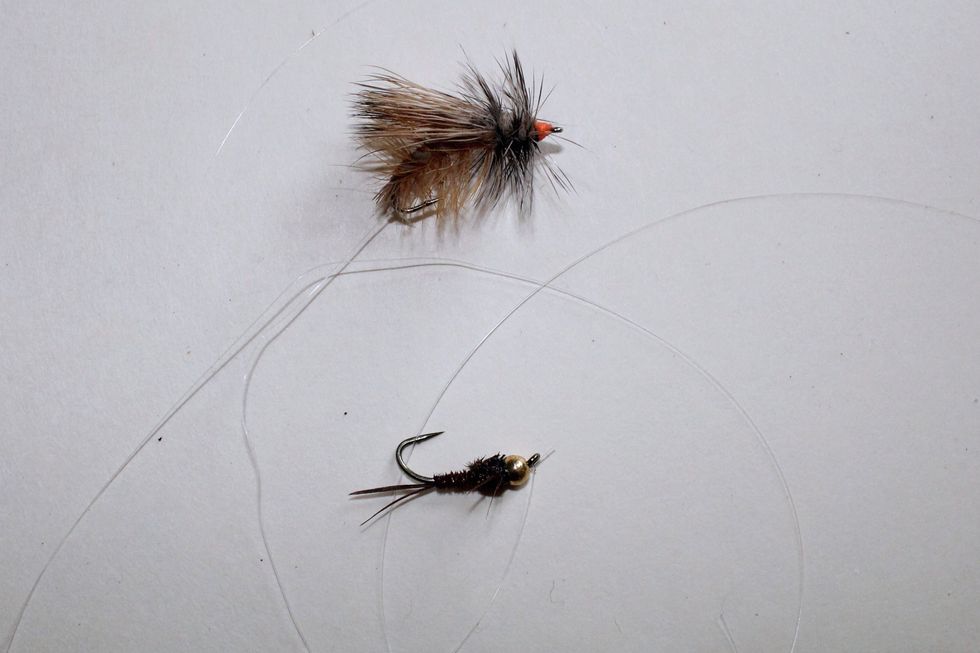The situation: The angler approaches the little blue line cautiously. The angler, disregarding the stiff joints and aching back, creeps up behind the boulder and peers at the plunge pool. The angler ties on a dry fly, and ever so carefully drops it right where the spooky wild brook trout is probably hiding.
And little dark shapes go whizzing around under the water, doing everything except taking that fly.
Congratulations, Pescador. You have just spooked the pool.
This happens all the time and there is no shame to it. However …
There is a solution, and it is called the dry-dropper.
What you need: One dry fly, highly visible and high-riding. Examples: Stimulator, any Wulff pattern, elk hair caddis, Parachute Adams.
Tie a piece of fluorocarbon tippet directly to the bend of the hook with a clinch knot. Fluoro is better than nylon because it sinks. I use Bozeman Flyworks fluorocarbon tippet, which comes in X ratings. (I mean 3X, 4X, 5X, not “XXX Must Be 18”).
For small streams this dropper should probably not be more than 2 feet in length.
Attach a small, weighted nymph to the dropper.
Let’s say you are using a seven foot rod, line weight four. Start with a store-bought seven-and-a-half foot leader, tapered to 4X. Cut off about 12 to 18 inches of the leader — about where it starts to get thicker — and tie your dry fly on there.
If it is too long and you are having trouble turning the rig over, you can adjust by moving the dry farther up the leader.
If it is too short, add a piece of nylon tippet to the leader and tie the dry on there.
If the dropper is getting tangled up, shorten it.
In short: Fiddle around with it. Eventually you’ll settle on something that works most of the time.
Then rethink your approach. Yes, trout tend to face upstream and yes, sneaking up on them from behind is often the way to go.
But not always.
Think of the little mountain stream as a series of discrete neighborhoods. Some neighborhoods are better approached from above. Sometimes the fish are hanging in the tailout, and will respond to a nymph or wet (or even a dry) that swings around in front of them.
Again, you’ll just have to experiment, knowing that what works in spot A may well be a disaster in spot B.
The dry fly is acting as an indicator here. Although quite often the fish will ignore the dropper that you have painstakingly assembled, and hit the big fly. Once in a great while you’ll get two fish at once.
But mostly you are watching the top fly. If it stops suddenly, or disappears, then something has grabbed the submerged fly.
Or the submerged fly is caught on something, like a stick, or a rock, or an alligator.
For maximum heresy, try this with a hard panfish popper, which won’t ever get waterlogged and sink, as even the bushiest and most gooped-up dry fly will.
Once you have established that there are fish in a given neighborhood, and they are willing to eat, you can then re-rig with a solo dry fly.
Or you can just keep moving.
Don’t be afraid to get big with your submerged fly. I like to start small and work up if needed. I do it this way because the tippet diameter necessary for the small (size 18-22) will also work for bigger (size 12-16), but not the other way around.
I like to use a smallish Stimulator (size 14) and a biggish nymph (size 14) tied together with four-pound Seaguar Inviz fluorocarbon line (sold for spinning rods). The clinch knot is on the bend of the hook of the Stimulator, and pay no attention to those Gloomy Guses who maintain clinch knots and fluoro don’t mix. I do it all the time.
Use a Davy knot to attach the dry fly to the leader and the nymph to the dropper.
Next time we will discuss streamside yoga positions (including “The Barfing Heron”) and Tenkara Euro-Mopping.










 Penguin Random House
Penguin Random House
 A needlework example.Cynthia Hochswender
A needlework example.Cynthia Hochswender Alexandra Peters, left, is exhibiting needlework samplers from her collection at the Litchfield Historical Society Museum.Cynthia Hochswender
Alexandra Peters, left, is exhibiting needlework samplers from her collection at the Litchfield Historical Society Museum.Cynthia Hochswender


